

Kubernetes 集群中流量暴露的几种方案-51CTO.COM
source link: https://www.51cto.com/article/712511.html
Go to the source link to view the article. You can view the picture content, updated content and better typesetting reading experience. If the link is broken, please click the button below to view the snapshot at that time.

在业务使用 Kubernetes 进行编排管理时,针对业务的南北流量的接入,在 Kuberentes 中通常有几种方案,本文就接入的方案进行简单介绍。
流量接入方案
Kuberentes 社区通过为集群增设入口点的方案,解决对外流量的管理。
通过 kube-proxy 进行代理
通常在最简单的测试或个人开发环境,可以通过 kubectl port-forward 来启动一个 kube-proxy 进程代理内部的服务至该命令执行的宿主机节点,如果该宿主机具备公网 IP,且转发监听端口为0.0.0.0就可以实现公网访问该服务,该方式可以代理单个 Pod,或者 Deployment,或者 Servcie。
$ kubectl port-forward -h
Forward one or more local ports to a pod. This command requires the node to have 'socat' installed.
Use resource type/name such as deployment/mydeployment to select a pod. Resource type defaults to 'pod' if omitted.
If there are multiple pods matching the criteria, a pod will be selected automatically. The forwarding session ends
when the selected pod terminates, and rerun of the command is needed to resume forwarding.
Examples:
# Listen on ports 5000 and 6000 locally, forwarding data to/from ports 5000 and 6000 in the pod
kubectl port-forward pod/mypod 5000 6000
# Listen on ports 5000 and 6000 locally, forwarding data to/from ports 5000 and 6000 in a pod selected by the
deployment
kubectl port-forward deployment/mydeployment 5000 6000
# Listen on port 8443 locally, forwarding to the targetPort of the service's port named "https" in a pod selected by
the service
kubectl port-forward service/myservice 8443:https
# Listen on port 8888 locally, forwarding to 5000 in the pod
kubectl port-forward pod/mypod 8888:5000
# Listen on port 8888 on all addresses, forwarding to 5000 in the pod
kubectl port-forward --address 0.0.0.0 pod/mypod 8888:5000
# Listen on port 8888 on localhost and selected IP, forwarding to 5000 in the pod
kubectl port-forward --address localhost,10.19.21.23 pod/mypod 8888:5000
# Listen on a random port locally, forwarding to 5000 in the pod
kubectl port-forward pod/mypod :5000NodePort 方式
其次较常用的为 NodePort 方式,将 K8s 中 service 的类型修改为 NodePort 方式,会得到一个端口范围在 30000-32767 端口范围内的宿主机端口,同样宿主机具有公网 IP 就可以实现对服务的暴露,但是 NodePort 会占用宿主机端口,一个 Service 对应一个 NodePort,该方式仅为四层,无法实现 SSL 证书的卸载,如果将服务转发到单个 Node 节点的 NodePort 也无法实现高可用,一般需要在 NodePort 前搭配负载均衡来添加多个后端 NodePort 已实现高可用。
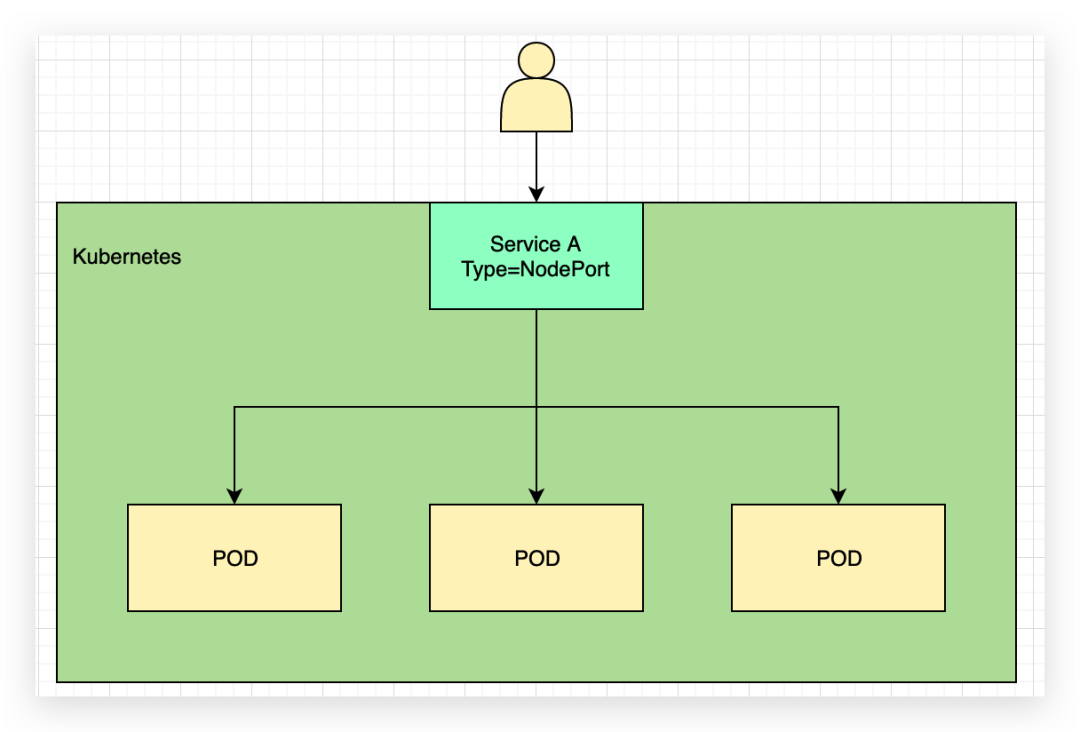
LoadBalancer
四层流量转发一个 LB 的端口只能对应一个 Service,Servcie 的 Type 为 NodePort,例如如下图,LoadBalancer 上的 88 端口对应转发到后端 NodePort 的 32111 端口,对应到 servcieA;LB 上的 8080 端口对应转发到后端 NodePort32001 端口;该方案可以通过添加多个 NodePort 方式实现高可用,但是由于为四层无法实现对 SSL 的卸载,对应 NodePort 需要在 LB 占用一个端口。
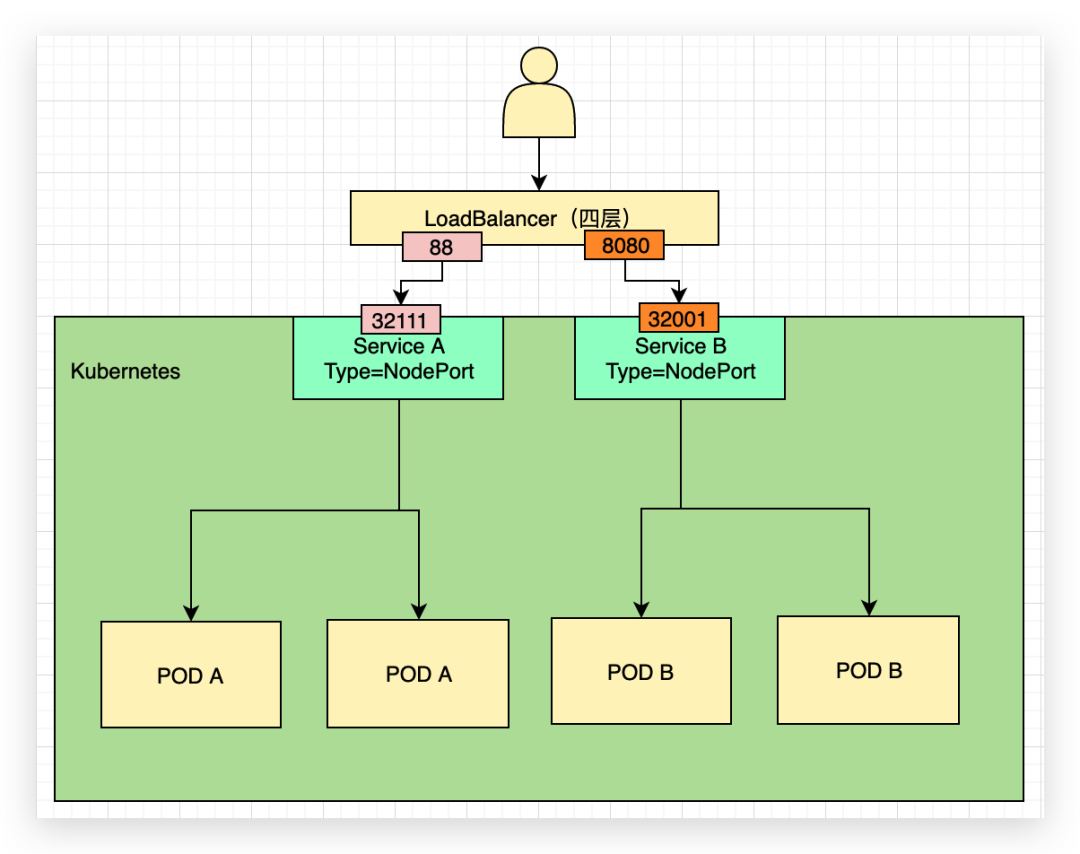
七层可以借助 LB 的域名转发,实现一个域名端口对应多个 Service,如图可以根据 path 路径,/cmp 对应 NodePort 的 32111,/gateway 对应 NodePort 的 32000 端口,不仅可以实现高可用,而且七层可以实现 SSL 卸载。
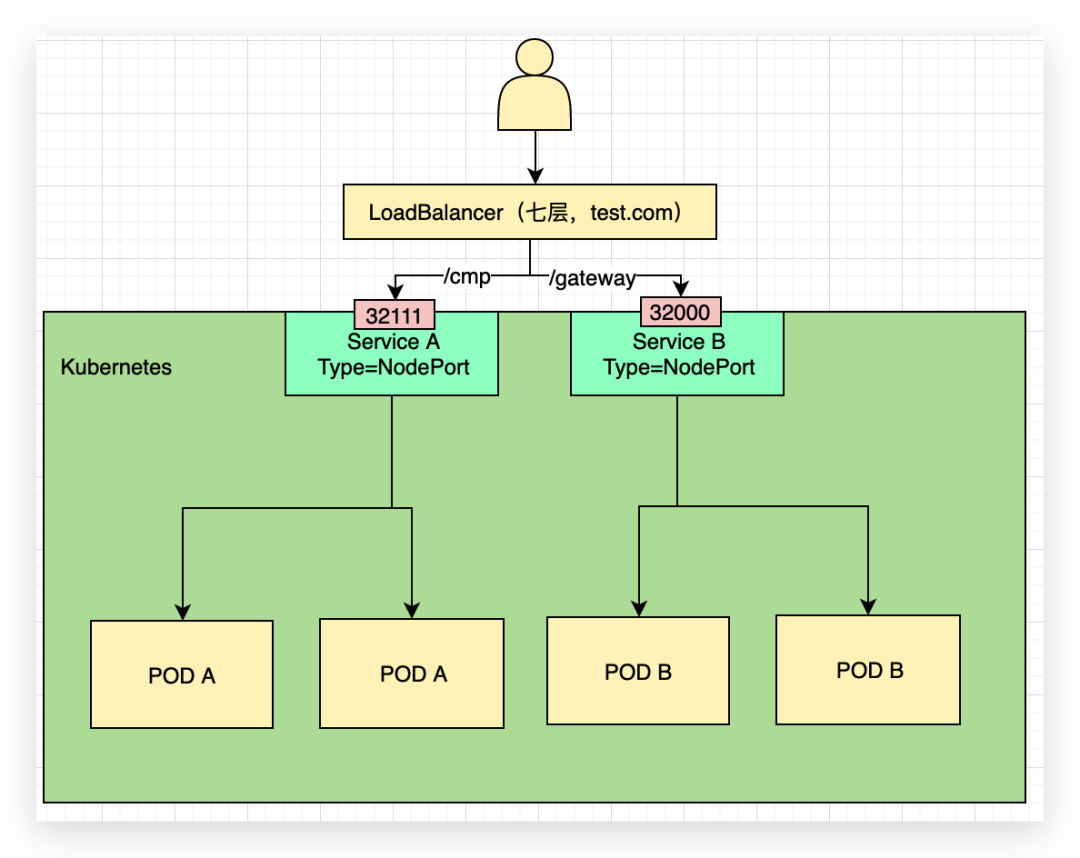
目前一般公有云的 LB 级别都具备四层和七层的功能,配合使用可以实现灵活的业务流量暴露。
Ingress
在 K8s 中,存在有 Ingress 资源来实现单个域名转发根据不同的路径或其他配置规则转发到 K8 集群内部不同的 Service,但是用户请求需要访问 Ingress 实现控制器的 NodePort 例如 Ingress-nginx 的 Controller 的 Service 的 NodePort,针对具体的业务域名一般不会带端口,所以一般前面还需要一层 80/443 的端口转发。
一般 Ingress 的 Controller 实现业界也有不少解决方案,例如比较知名的 Ingress—nginx/Ingress-traefik 等。
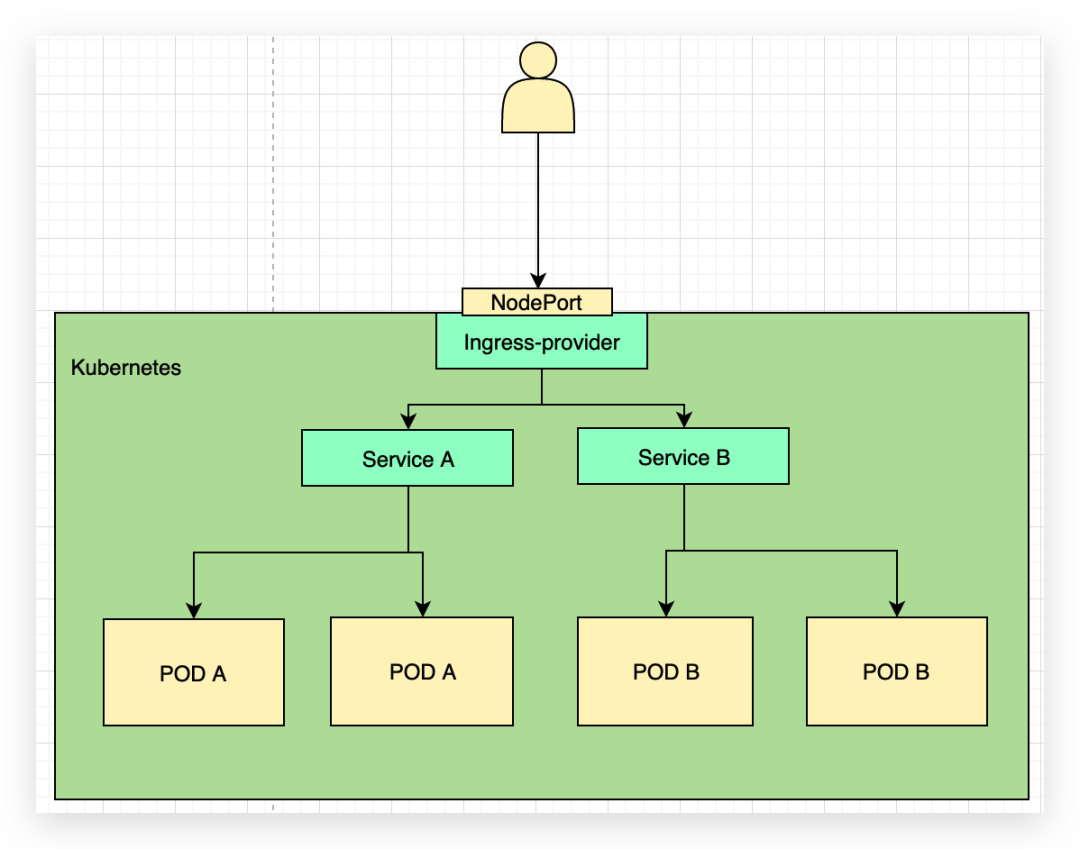
LoadBalancer + Ingress
如下图所示在最前面有一个四层 LB 实现端口 80/443 转发至 ingress-provider 的 Service 的 NodePort,K8s 集群内部配置有多个 service。
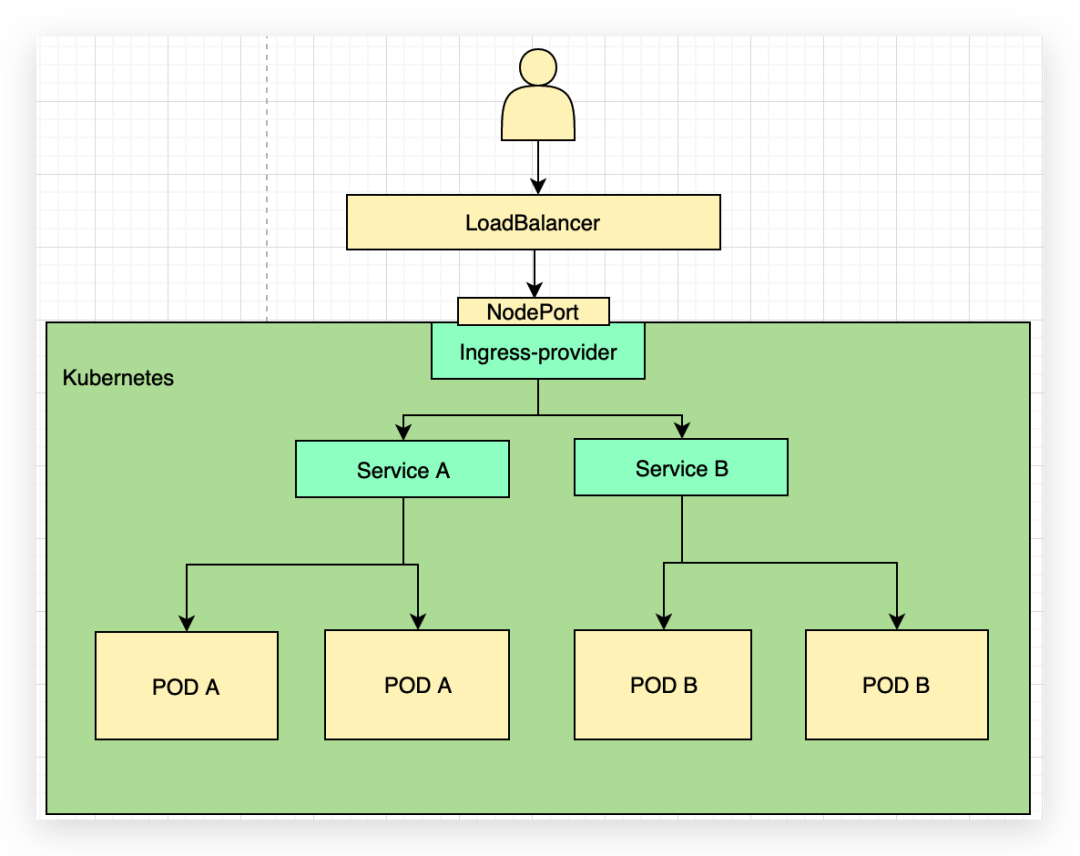
Ingress-nginx 详解
在上面的几种方案中,均有用到 Ingress,Nginx-ingress 为 Nginx 官方提供的实现 K8s ingress 资源的方案,同时 Kubernetes 官方也提供了基于 Nginx 实现的 Ingress 方案。
Nginx Ingress 由资源对象 Ingress、Ingress 控制器、Nginx 三部分组成,Ingress 控制器的目标是构建完成一个配置文件(nginx.conf),主要通过检测配置文件发生改变后重载 Nginx 实现,但并不是仅在 Upstream 更改时重载 Nginx(部署应用程序时修改 Endpoints),使用 lua-nginx-module 实现。
根据下图可以更好理解 Ingress-nginx 的使用场景。
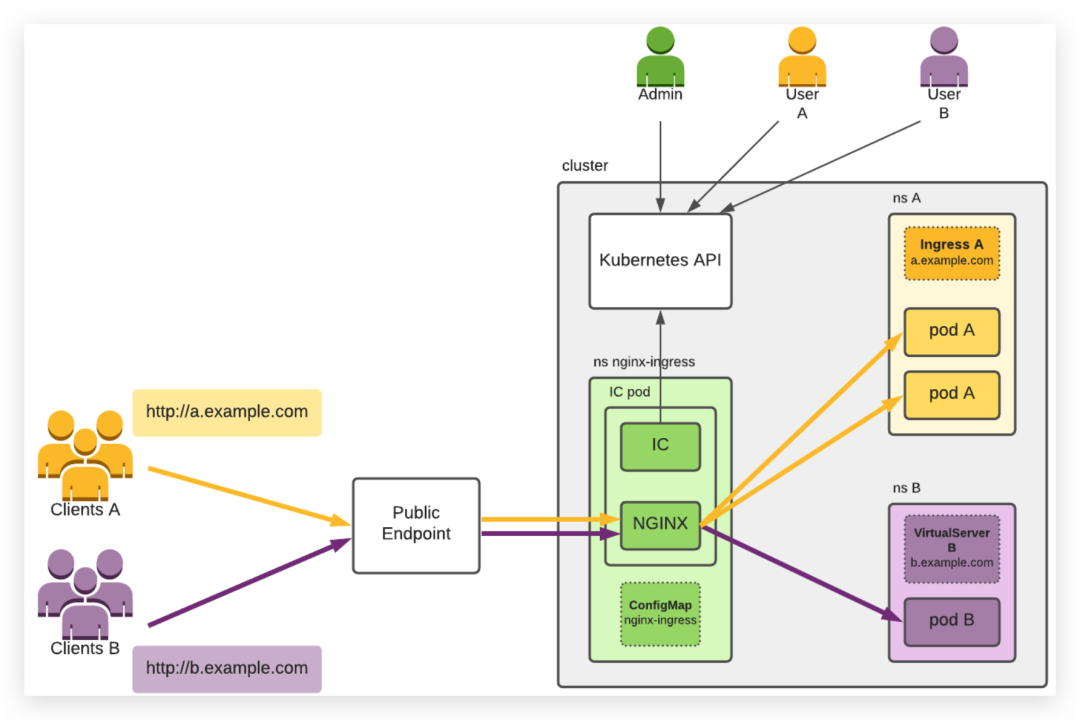
图中展示如下信息:
- 一个 K8s 集群。
- 集群用户管理、用户 A 和用户 B,它们通过 Kubernetes API 使用集群。
- 客户端 A 和客户端 B,它们连接到相应用户部署的应用程序 A 和 B。
- IC,由 Admin 部署在名称空间 nginx-ingress 中的 pod 中,并通过 ConfigMap nginx-ingress 进行配置。Admin 通常部署至少两个 pod 以实现冗余。IC 使用 Kubernetes API 获取集群中创建的最新入口资源,然后根据这些资源配置 NGINX。
- 应用程序 A 由用户 A 在命名空间 A 中部署了两个吊舱。为了通过主机 A.example.com 向其客户机(客户机 A)公开应用程序,用户 A 创建入口 A。
- 用户 B 在命名空间 B 中部署了一个 pod 的应用程序 B。为了通过主机 B.example.com 向其客户机(客户机 B)公开应用程序,用户 B 创建 VirtualServer B。
- 公共端点,它位于 IC 吊舱前面。这通常是一个 TCP 负载均衡器(云、软件或硬件),或者这种负载均衡器与 NodePort 服务的组合。客户端 A 和 B 通过公共端点连接到他们的应用程序。
黄色和紫色箭头表示与客户端通信量相关的连接,黑色箭头表示对 Kubernetes API 的访问。
为了简单,没有显示许多必要的 Kubernetes 资源,如部署和服务,管理员和用户也需要创建这些资源。
在 K8s 中,通常云厂商的 LB 一般云厂商提供适配 CNI,会在创建 K8s 集群时会自动创建 LB 类型的 servcie,例如阿里的 ACK,腾讯的 TKE,华为的 CCE 等,但是在我们自建或个人测试场景,开源的 Metallb[1]是一个不错的选择,其作用通过 K8s 原生的方式提供 LB 类型的 Service 支持,开箱即用,当然还有青云科技 KubeSphere 团队开源的负载均衡器插件 OpenELB[2],是为物理机(Bare-metal)、边缘(Edge)和私有化环境设计的负载均衡器插件,可作为 Kubernetes、K3s、KubeSphere 的 LB 插件对集群外暴露 “LoadBalancer” 类型的服务。在 2021 年 11 月已进入 CNCF 沙箱(Sandbox)托管,也是解决用户将 Kubernetes 集群部署在裸机上,或是私有化环境特别是物理机或边缘集群,Kubernetes 并不提供 LoadBalancer 的痛点,提供与基于云的负载均衡器相同的用户体验。
[1]Metallb: https://github.com/metallb/metallb。
[2]OpenELB: https://openelb.io/。
Recommend
About Joyk
Aggregate valuable and interesting links.
Joyk means Joy of geeK